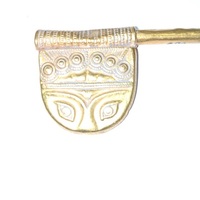Papers by Christina Konstantina Kousouni
Islamic art is present around the world, Benaki Museum, Museum of Islamic Art (Athens, Greece) ha... more Islamic art is present around the world, Benaki Museum, Museum of Islamic Art (Athens, Greece) has a col-lection of various objects, a part of this collection was studied through portable XRF analysis. The objects that were studied are sixteen (16) metallic Islamic artifacts; three candlesticks, six basins, a cup, an ewer, two com-passes, two pen boxes and an incense burner. These artifacts are dated in the 13th to 15th century, with origin from Iran, Syria, Turkey and Egypt, and are of great aesthetic value and the unique metalworking techniques revealed by their shapes, decorations and complex manufacturing alloys. Portable X-ray fluorescence analysis provided information about the artifacts' construction materials, which were mainly copper, zinc, iron, lead, tin and nickel.
Scientific Culture, 2021
Islamic art is present around the world, Benaki Museum, Museum of Islamic Art (Athens, Greece) ha... more Islamic art is present around the world, Benaki Museum, Museum of Islamic Art (Athens, Greece) has a collection of various objects, a part of this collection was studied through portable XRF analysis. The objects that were studied are sixteen (16) metallic Islamic artifacts; three candlesticks, six basins, a cup, an ewer, two compasses, two pen boxes and an incense burner. These artifacts are dated in the 13th to 15th century, with origin from Iran, Syria, Turkey and Egypt, and are of great aesthetic value and the unique metalworking techniques revealed by their shapes, decorations and complex manufacturing alloys. Portable X-ray fluorescence analysis provided information about the artifacts' construction materials, which were mainly copper, zinc, iron, lead, tin and nickel.

Scientific Culture, 2018
In this article, six metallic book covers of ecclesiastical books and a metallic pair of church o... more In this article, six metallic book covers of ecclesiastical books and a metallic pair of church ornaments, used as a decorative in the church, are studied. These objects are dated in the 19th century and derive from Saint Mavra and Timotheos Church in Zakynthos Island in Greece. Physicochemical analysis provided information, such as the construction metals, which was brass (copper and zinc alloy) in five of them with nickel as coating, one was made of silver along with the pair of church ornaments and specimens of enamels in various colors (blue, green, red), in order to proceed to the collection’s conservation.Specifically, Stereo Microscope was used in order to provide information about the microscopic features and X-ray fluorescence to grant with both quantitative and qualitative results of the chemical composition. The conservation method based on the results of the physicochemical analysis was decided, aqueous solutions of chemicals and pastes were used after the proper cleaning tests, as the procedure was completed the objects were in a stable state,protected by a varnish coating from further corrosion. The results of the study and the conservation process are documented, providing important information about metalwork in the 19th century in Zakynthos Island and the conservation approach.
e-Journal of Science & Technology, (e-JST), 2017
Metalworking and Ecclesiastical metalworking in Greece have a long course through history. This k... more Metalworking and Ecclesiastical metalworking in Greece have a long course through history. This kind of art is the metals' processing techniques that vary according to the kind of the metal and the objects that were to be constructed. The most common metals used, are gold, silver, copper, brass and less of all lead. Luxurious metallic bindings have been found in holy books. The construction of a metallic book cover needs a lot of effort and resources. In Zakynthos Island (Greece) there is a tremendous tradition in metalworking, mostly with silver and gold.










Uploads
Papers by Christina Konstantina Kousouni